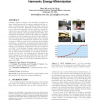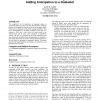824 search results - page 145 / 165 » Exploring Human Visualization of Computer Algorithms |
ISVC
2007
Springer
14 years 2 months ago
2007
Springer
Optical motion capture can be classified as an inference problem: given the data produced by a set of cameras, the aim is to extract the hidden state, which in this case encodes t...
CVPR
2009
IEEE
15 years 25 days ago
2009
IEEE
Central to many problems in scene understanding based on using a network of tens, hundreds or even thousands of randomly distributed cameras with on-board processing and wireless c...
MM
2006
ACM
14 years 2 months ago
2006
ACM
Labeling objects in images is an essential prerequisite for many visual learning and recognition applications that depend on training data, such as image retrieval, object detecti...
AGENTS
2001
Springer
14 years 1 months ago
2001
Springer
The complexity of AI characters in computer games is continually improving; however they still fall short of human players. In this paper we describe an AI bot for the game Quake ...
BMCBI
2007
13 years 8 months ago
2007
Background: Identity by descent (IBD) matrix estimation is a central component in mapping of Quantitative Trait Loci (QTL) using variance component models. A large number of algor...



